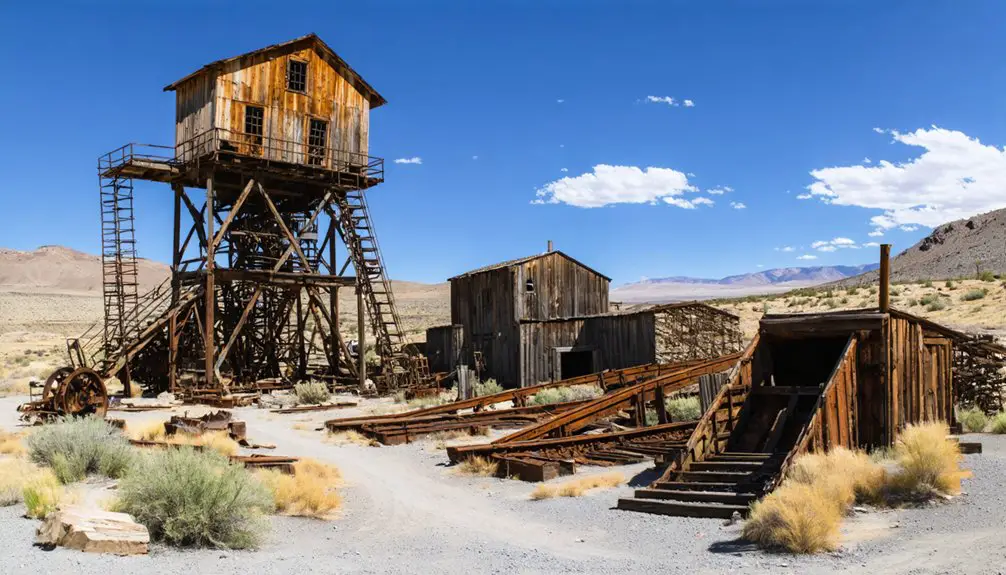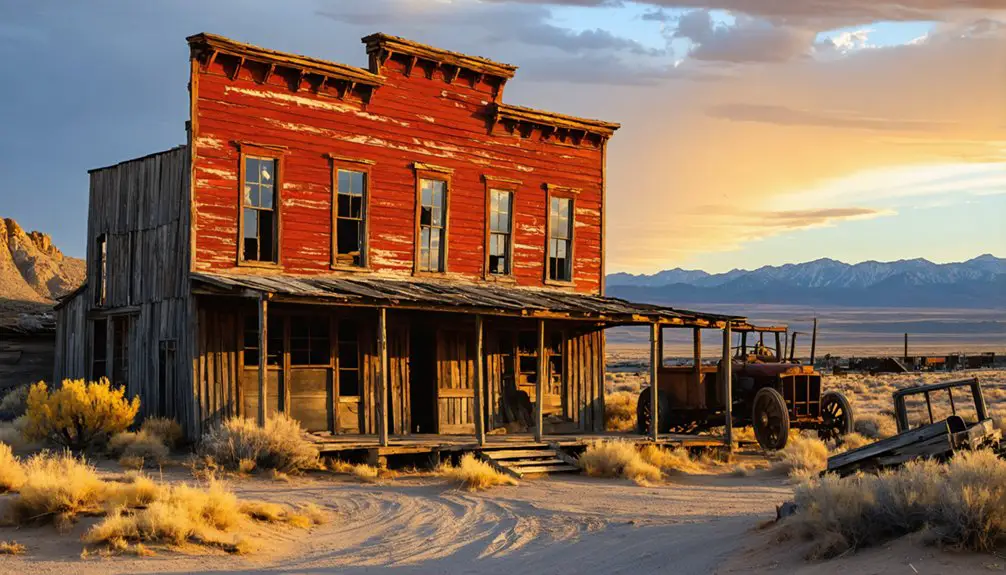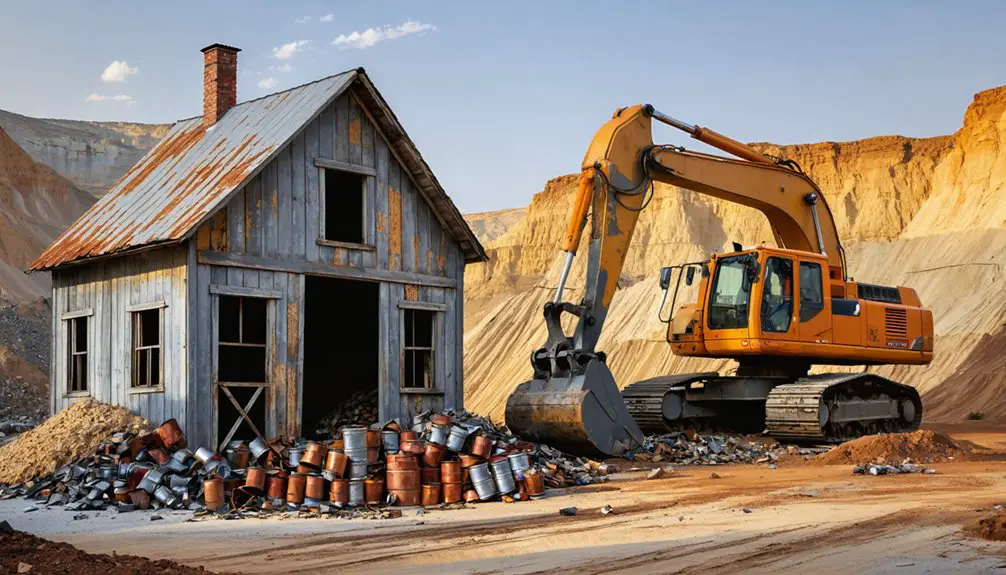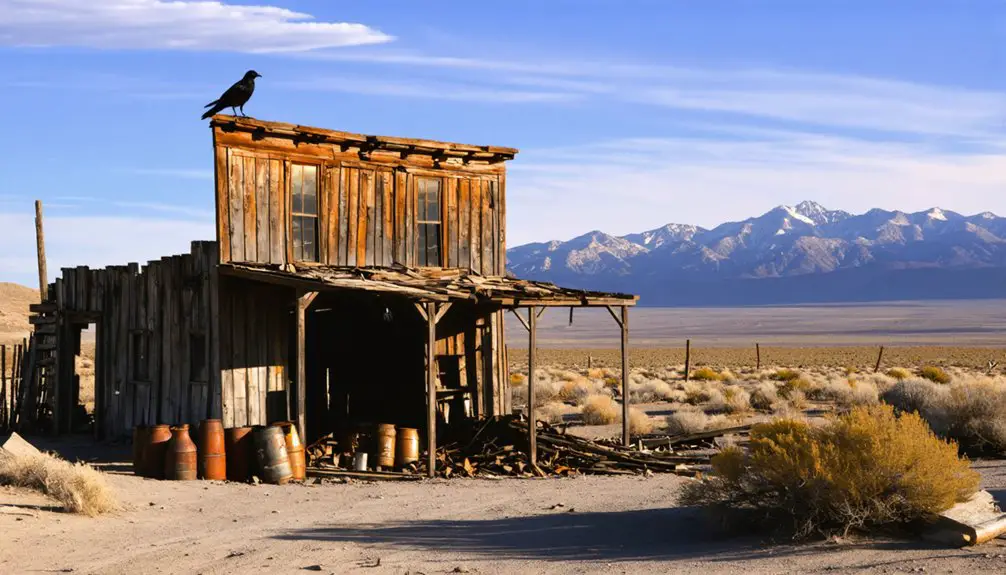You’ll find Tenabo in central Nevada’s Lander County, where Charles Montgomery’s 1905 gold discovery sparked a mining boomtown that quickly grew to 1,000 residents. The settlement flourished with hotels, saloons, and essential services until declining silver prices and rising extraction costs led to its abandonment by 1912. While most structures have deteriorated, you can still explore this ghost town‘s remnants via dirt roads, though you’ll need a high-clearance vehicle to reveal its full mining-era story.
Key Takeaways
- Tenabo was a mining boomtown established in 1905 after Charles Montgomery’s gold discovery, quickly growing to 1,000 residents within two years.
- The town featured essential amenities including hotels, saloons, restaurants, and a post office during its peak between 1907-1911.
- Mining operations declined by 1911 due to rising costs, leading to abandonment, with the post office closing in 1912.
- Mill Gulch near Tenabo became Nevada’s leading placer gold producer by 1938, extending the area’s mining significance.
- Today, Tenabo is accessible via dirt roads, with deteriorating buildings remaining as remnants of its mining-era past.
The Origins Behind Tenabo’s Name
While the precise origin of Tenabo’s name remains debated among historians, two compelling theories have emerged from historical records and linguistic research.
The first suggests New Mexican settlers brought the name from an ancient pueblo in their homeland, reflecting the common practice of miners naming new settlements after familiar places.
The second theory traces the name etymology to Paiute origins, translating to “dark colored water” – a reference to local water sources that proved essential for the mining community’s survival.
The cultural significance of Tenabo’s name captures the intersection of indigenous heritage and settler influence in Nevada’s mining history.
Place names across Nevada tell powerful stories of cultural convergence between Native peoples and western settlers who shaped the region.
You’ll find this dual origin story mirrored in many Western ghost towns, where Native American language and settler traditions merged to create lasting place names.
The town’s location 35 kilometers from Campeche likely influenced early settlement patterns and naming conventions.
After silver was discovered, the town quickly grew to support a population of 1000 shortly after its establishment in 1907.
A Gold Rush Sparks a Town
Charles Montgomery’s 1905 gold discovery on the eastern slope of Nevada’s Shoshone Range sparked an influx of fortune seekers to what would become Tenabo.
Within two years, you’d have witnessed a full-fledged gold rush transforming the site into a bustling mining camp of 1,000 residents. The rapidly growing community soon boasted essential amenities including a hotel, restaurant, school, and multiple saloons, though water scarcity remained a persistent challenge for the settlement. A stage line to Beowawe provided thrice-weekly transportation services for the town’s residents. Similar to many mining sites documented in Old Heart of Nevada, Tenabo represents another important chapter in Elko County’s rich mining heritage.
Gold Discovery Ignites Settlement
In 1905, the discovery of gold near Tenabo ignited a transformative rush that would shape the region’s destiny.
You’ll find that within just two years, this once-empty landscape transformed into a bustling settlement of 1,000 residents, drawn by the promise of both gold and silver strikes in the Bullion Mining District.
The gold rush spurred rapid development as settlers carved out their piece of the Nevada frontier. The rapid mining expansion occurred on Western Shoshone land, though their ownership rights were systematically ignored.
You can trace the settlement patterns through the swift construction of wooden buildings and the careful platting of the townsite.
The discovery proved so promising that by 1906-1907, when silver was found nearby, Tenabo had positioned itself as one of Nevada’s last true mining boom towns, where fortune seekers built their community around the precious metal deposits that beckoned them west. The district’s ore deposits contained valuable fissure veins rich in various sulfides and gold.
Montgomery’s Lucky Strike 1905
The remarkable Lucky Strike discovery of 1905 marked the true beginning of Tenabo’s mining saga.
You’ll find Montgomery’s legacy deeply woven into this story, as he unearthed rich gold deposits on the Shoshone Range’s eastern slope. His discovery sparked a classic Nevada gold rush, with assays showing phenomenal values of $700 per ton.
Bullfrog speculation reached fever pitch as mining companies rushed to incorporate, many simply capitalizing on the name recognition. Similar to the 165 mining companies that operated in the Bullfrog District by 1906, prospectors flooded into the area seeking fortune. The area saw twenty saloons established within months, indicating substantial wealth flowing through the region.
You’d have seen claim prices soaring between $500 and $2,000, even before any real development began. The Montgomery Shoshone Mine emerged as the district’s powerhouse, transforming Tenabo from a tent settlement into a bustling mining camp.
While many surrounding claims proved worthless, the original strike sustained operations through 1909, processing lower-grade ore that kept the town’s hopes alive.
Boom Creates Mining Community
Following Montgomery’s sensational gold strike in 1905, a classic Nevada boomtown emerged as prospectors and fortune seekers flocked to Tenabo’s promising eastern slopes.
Life in Early Tenabo
Booming with activity after gold and silver discoveries in 1906, Tenabo quickly transformed from empty desert into a bustling mining settlement of 1,000 residents by 1907.
The community dynamics reflected both rugged frontier spirit and family values, with miners, merchants, and their families establishing homes, businesses, and a school.
You’d find typical boomtown establishments like saloons, restaurants, hotels, and brothels lining the streets, while essential services included a post office, assay office, and grocery store.
Daily challenges centered on water scarcity – you’d have to haul it from distant springs.
A tri-weekly stagecoach to Beowawe provided your connection to the outside world.
Life revolved around the mines and mill in Mill Gulch, where you’d spend your days working before gathering at local saloons and eateries for evening socializing.
The Tenabo Mining and Smelting Company gained control of most local mining operations by 1909, consolidating the area’s mineral wealth under one entity.
By 1911, the town began to decline as high production costs made mining operations increasingly difficult to sustain.
Mining Operations and Economic Peak

Shortly after silver’s discovery in 1907, Tenabo’s mining operations rapidly expanded under the control of Tenabo Mining and Smelting Company, which invested heavily in infrastructure to support the Little Gem mine.
You’d have found a bustling town of nearly 1,000 residents, complete with saloons, hotels, and assay offices during the peak years of 1907-1911.
Mining techniques evolved dramatically over time, from early silver ore extraction to sophisticated placer mining operations.
From basic silver extraction to advanced placer operations, mining methods transformed as Tenabo’s industry matured and evolved.
By 1938, Mill Gulch became Nevada’s leading placer producer, with companies operating large floating dredges throughout the 1930s.
However, economic fluctuations took their toll. Rising extraction costs surpassed ore values by 1911, leading to scaled-back operations.
Despite a brief revival attempt in 1916, the town’s fortunes continued to decline, particularly after the 1930s collapse of silver prices.
The Short-Lived Boom Years
The discovery of rich silver and gold deposits in 1906 sparked an immediate rush that would transform Tenabo from empty desert into a thriving frontier settlement.
By 1907, you’d have found yourself among nearly 1,000 residents experiencing one of Nevada’s quintessential ghost town experiences, as wooden buildings rapidly rose from the desert floor.
The town’s mining heritage flourished briefly with essential infrastructure taking shape – saloons, hotels, restaurants, and even a school served the bustling community.
You could catch the tri-weekly stage to Beowawe, conduct business at the assay office, or visit the Little Gem mine, the district’s largest operation.
The Tenabo Mining and Smelting Company dominated local mining activities until 1909, but by 1911, declining ore values began spelling trouble for this desert boomtown.
From Bustling Town to Abandonment

Despite Tenabo’s promising start, its fate was sealed when mining costs began exceeding ore values in 1911, triggering a swift exodus from this once-bustling frontier settlement.
Rising costs and falling ore values brought Tenabo’s mining dreams to an abrupt end, emptying the bustling frontier town.
The social dynamics shifted dramatically as the post office closed in July 1912, marking the official beginning of the town’s decline. You can trace the collapse through the Tenabo Mining and Smelting Company’s withdrawal, as they sold all holdings by 1920.
While the discovery of placer gold in Mill Gulch during 1916 offered a glimmer of hope, it couldn’t restore Tenabo’s former glory. Resource management challenges, particularly water scarcity, had long plagued operations.
Today, you’ll find only scattered wooden structures, an old head frame, and ore storage sheds – silent witnesses to the town’s rapid transformation from boom to bust.
Placer Mining’s Second Wave
While Tenabo’s initial mining ventures had faltered, a remarkable second chapter began in 1916 when A.E. Raleigh discovered placer gold in Mill Gulch, establishing a new camp bearing his name.
You’ll find that placer mining techniques evolved rapidly during this period, from simple drywashing to sophisticated dredging operations. By 1938, Mill Gulch had become Nevada’s leading placer gold producer, with the Mill Gulch Placer Mining Company operating advanced dragline dredges and washing plants.
The economic impact was significant, particularly during the Great Depression, as placer mining offered lower-cost operations than traditional hard rock mining.
Despite water scarcity challenges in Lander County, companies invested in floating dredges and hydraulic mining infrastructure, transforming small-scale prospecting into industrial-scale operations that continued well into the 1940s.
Modern Mining Activities

Since Barrick Gold announced plans for the Mount Tenabo Open-Pit Mine Project, modern mining has dramatically transformed this historic region.
Modern mining operations have revolutionized Nevada’s landscape since Barrick Gold unveiled its ambitious Mount Tenabo project.
You’ll find state-of-the-art mining technology deployed across multiple operations, including the Goldrush Mine’s underground systems and Nevada Gold Mines’ expanding surface operations.
The environmental impact of these developments has sparked intense debate.
You’re looking at a proposed 2,200-foot-deep pit that’ll permanently alter 817 acres of pinion forest, while Western Shoshone tribes continue fighting for their ancestral lands under an 1863 treaty.
Mining companies have invested heavily in environmental assessments and mitigation strategies, including paste plants and reclamation programs, but concerns persist about effects on local springs and air quality.
Despite controversy, these projects maintain Nevada’s position as America’s leading gold producer.
Visiting the Ghost Town Today
You’ll find Tenabo accessible via two well-maintained dirt roads, though a high-clearance vehicle is recommended for the journey.
The ghost town’s remaining wooden structures and foundations offer glimpses of its mining-era past, with remnants of saloons, hotels, and the town school still visible among the ruins.
When exploring the site, you’ll need to stay alert for hazards from deteriorating buildings and active mining operations nearby, while bringing plenty of water and supplies since no services exist in this remote location.
Access and Road Conditions
Reaching Tenabo ghost town requires careful navigation through Nevada’s remote terrain, with access primarily via state highways from Elko or Battle Mountain before shifting to unpaved roads.
You’ll need to rely on maps or GPS, as signage is limited along the rural routes leading to the site.
Road navigation becomes more challenging once you leave the paved highways maintained by NDOT. High-clearance vehicles or 4WD are recommended for the dirt and gravel sections, especially during wet conditions.
Seasonal challenges can greatly impact accessibility – spring and fall typically offer the best driving conditions, while winter snow and spring rains can make roads impassable.
You’ll want to check NDOT’s 511 system for updates and carry emergency supplies, as cell service is sparse in this remote region.
Remaining Historical Structures
The skeletal remains of Tenabo’s historic structures offer visitors a compelling window into Nevada’s mining past.
You’ll find original wooden buildings including a saloon and general store along the main street, arranged in a layout typical of early 1900s mining towns. Behind the town center, there’s an intact ore storage shed, while a weathered head frame and ore overshoot stand as evidence to the area’s mining heritage.
Despite preservation challenges from active mining operations nearby, several frame houses and civic buildings have endured, including remnants of a hotel, restaurant, school, and assay office.
The architectural significance of these structures is evident in their classic western mining town design, though most are now weathered ruins. Mill Gulch’s processing facilities and scattered mining equipment further document Tenabo’s industrial past.
Safety Precautions When Exploring
While Tenabo’s historic structures beckon exploration, visiting this remote ghost town requires careful preparation and awareness of potential hazards.
You’ll need proper safety gear, including sun protection, emergency supplies, and off-road vehicle recovery equipment. Travel tips emphasize bringing extra water, food, and medical supplies, as services are nonexistent in this isolated area.
Always travel with companions and inform others of your plans. Your vehicle should have high clearance and be well-maintained for the rough, unpaved roads.
Watch for unstable ground, sudden weather changes, and wildlife. Don’t disturb or remove artifacts, as they’re protected by law. Practice Leave No Trace principles and avoid climbing on deteriorating structures.
Bring GPS devices and maintain communication capabilities to guarantee a safe adventure exploring this historical site.
Frequently Asked Questions
What Natural Disasters or Significant Accidents Occurred in Tenabo’s Mining History?
You won’t find documented flooding incidents or major mining accidents specifically in Tenabo’s records, though the region experienced typical Nevada mining hazards like shaft falls and suffocation risks.
Were There Any Notable Criminal Activities or Lawlessness During Tenabo’s Peak?
While you’d expect wild tales of lawlessness, there’s no documented evidence of major criminal activities in Tenabo. Despite typical mining disputes and limited law enforcement, records don’t show significant disorder during peak years.
What Indigenous Artifacts Have Been Discovered in the Tenabo Area?
You’ll find stone projectile points, knives, and scrapers near Tenabo, reflecting indigenous history of hunting and hide processing. The region’s artifact preservation also reveals milling equipment for plant processing.
Did Any Famous Historical Figures Ever Visit or Live in Tenabo?
Despite housing 1,000 residents during its peak, you won’t find famous visitors or historical connections to well-known figures in Tenabo’s records. The town mainly attracted miners and prospectors seeking fortune.
What Was the Average Salary of Miners Working in Tenabo?
You’d find mining wages in Tenabo ranged from $3-$5 daily around 1900, with skilled miners earning up to $8. The economic impact of declining ore values after 1911 likely reduced these wages considerably.
References
- https://en.wikipedia.org/wiki/Tenabo
- https://www.ghosttowns.com/states/nv/tenabo.htm
- https://www.nvexpeditions.com/lander/tenabo.php
- https://www.nevadaghosttownsandmininghistory.com/portfolio-2/tenabo
- https://forgottennevada.org/sites/tenabo.html
- http://www.raydunakin.com/Site/Cortez_NV.html
- https://www.mininghistoryassociation.org/ElkoNevada2021.htm
- https://sacredland.org/mount-tenabo-united-states/
- https://westernmininghistory.com/library/125/page1/
- https://pubs.usgs.gov/bul/1356/report.pdf



